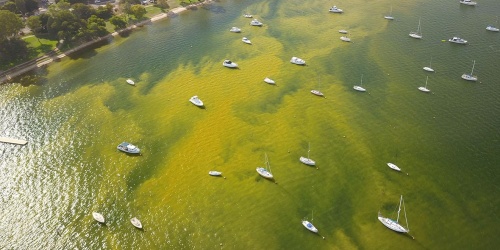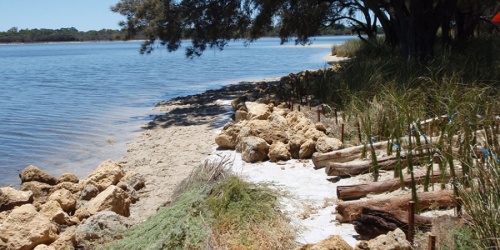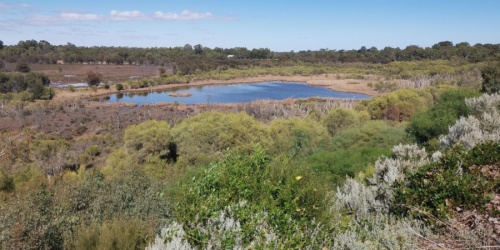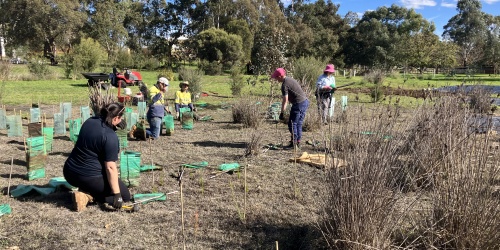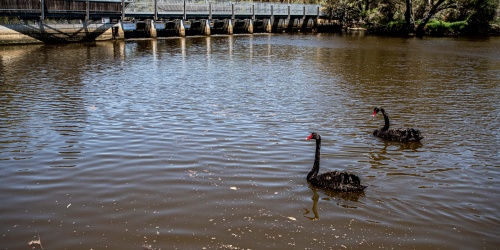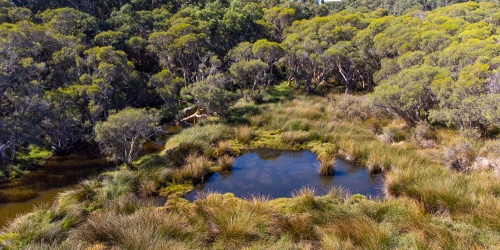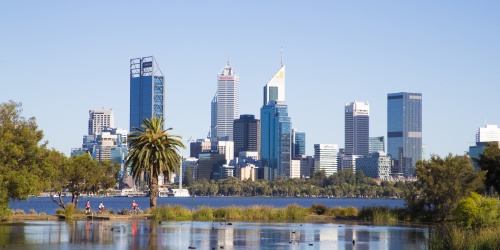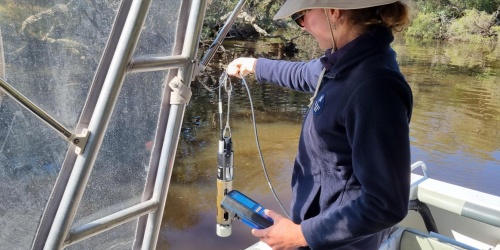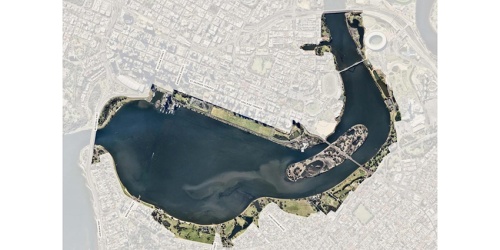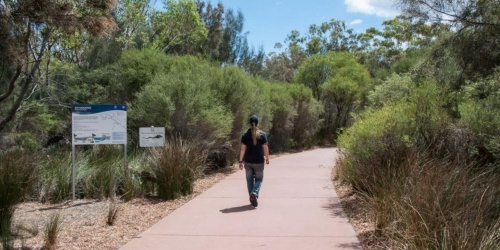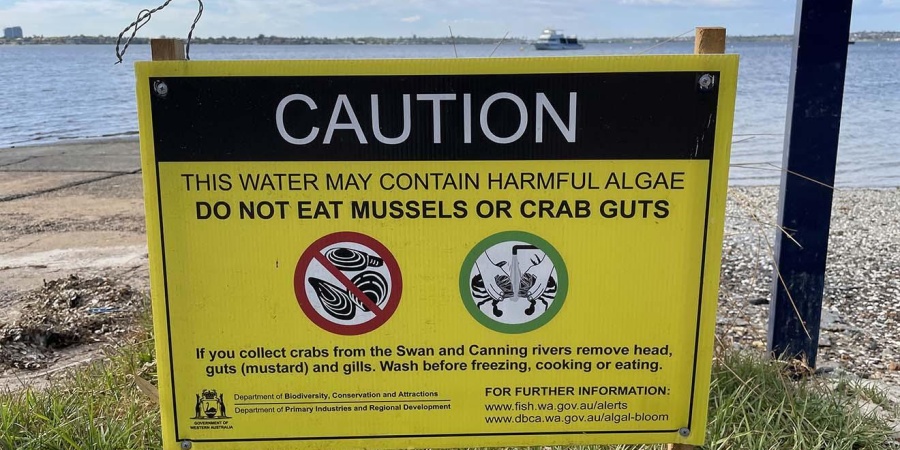
Swan Canning Riverpark warning sign
The Swan and Canning rivers make up a highly productive system that is showing similar signs of environmental stress to other urban waterways around the world.
Nutrients
Nutrient and non-nutrient contaminants enter the rivers through drains, surface runoff and groundwater. These can impact the water quality and the health of the waterway.
Nutrients include nitrogen, phosphorus, and organic carbon. The most common sources of nutrients entering our rivers include:
- fertilisers
- plant matter (e.g., grass clippings, leaves)
- detergents
- sewage
- animal waste
Nutrients are essential for plant growth, including algae, but excess nutrients can fuel algal blooms, promote harmful algae, and drive low oxygen conditions and fish kills.
Find out more about initiatives to address nutrient and organic loading.
Algal blooms
Algae are aquatic plants and are a natural part of our rivers and estuary.
There are many different types of algae. Some are microscopic and float in the water column (phytoplankton). Others are more obvious and grow as long thin filaments or thalli (macroalgae) that may attach to a substrate (e.g., rocks, shells, seagrass) or be free-floating.
Algae are an important part of the ecosystem. They provide food, habitat, and oxygenate the water during daylight hours. Like most plants, algae need warmth, light and nutrients to grow, but when increased nutrients or other factors alter the balance of the ecosystem, algal blooms can occur.
Phytoplankton are not visible to the naked eye, but when these bloom they can be seen as discoloured water. Some phytoplankton species are toxic and can cause issues for humans and wildlife when they bloom.
Macroalgae can accumulate in thick mats in shallow water and wash up onto beaches. Rotting masses of macroalgae give off unpleasant rotten-egg gas and can compete with seagrasses for light and nutrients.
Decomposition of phytoplankton or macro-algae blooms, or night-time respiration of dense accumulations, can deplete oxygen levels in the water column and negatively impact invertebrates, fish, and seagrass. This can result in the release of nutrients from the sediment, helping to further fuel algal blooms.
Find out more about algal blooms.
Harmful algae
Some species of algae can pose a health risk to humans or other animals. This can be:
Direct - through contact with or swallowing water affected by harmful algae. This may lead to skin, ear, respiratory or intestinal complaints.
Indirect - through eating shellfish (e.g., mussels) or other seafood that have accumulated algal biotoxins in their edible tissue. This can result in paralytic, diarrhetic, neurotoxic or amnesic shellfish poisoning. In some parts of the world this has proven fatal. The Health Department warns against the consumption of wild shellfish from the rivers and estuary because it cannot guarantee their quality.
Livestock and pets can be affected by skin contact or swallowing harmful algae. Fish can be killed by algae releasing toxins into the water column or coating their gills with a mucous-like substance.
DBCA monitors the abundance of harmful algal species in the Swan Canning Riverpark and the Department of Health will close off areas to swimming or fishing if required. Three species that the Department keeps a close watch on include:
- Microcystis aeruginosa – a blue-green algae that can secrete toxins into the water. This can cause skin, eye and ear allergies as well as gastroenteritis in humans and other animals. Microcystis prefers warm, still freshwater. It is more suited to conditions above the Kent Street Weir in the Canning River, but in February 2000 a summer flood provided ideal conditions in the wider estuary. This forced the closure of large parts of the Swan and Canning rivers. At high densities, Microcystis will make water appear a rich green colour.
- Karlodinium veneficum - high densities of this tiny dinoflagellate alga have been associated with fish kills in the Swan Canning. It prefers estuarine conditions. Karlodinium cells contain a toxin that can damage fish gills, resulting in them being unable to extract oxygen from the water.
- Alexandrium spp - this genus of microalgae contains several species that produce toxins known as Paralytic Shellfish Toxins (PSTs). These can be concentrated by filter-feeding shellfish. Consumption of shellfish containing high levels of these toxins can result in paralytic shellfish poisoning. This can cause muscular paralysis and death due to respiratory failure. Crabs may bioaccumulate PSTs with the majority of toxin retained in the viscera (guts). Find out more about Alexandrium.
Low oxygen conditions
Adequate dissolved oxygen in the water is crucial for aquatic life. Low oxygen causes stress to aquatic organisms. Very low levels of oxygen over prolonged periods can cause unpleasant odours and excessive nutrient release from sediments, which encourages algal blooms.
Dissolved oxygen levels are categorised as:
well oxygenated (> 6 mg/L)
oxygenated (> 4 and ≤ 6 mg/L)
low oxygen (> 2 and ≤ 4 mg/L)
hypoxic (> 0 and ≤ 2 mg/L)
anoxic (0 mg/L)
Low oxygen conditions in the rivers can be caused by:
Decomposition of excess organic matter (e.g., algae blooms, leaves, debris, pet/livestock waste, wastewater overflows) by naturally occurring microbes. These need oxygen to metabolise; the more active they are, the more oxygen they remove from the water. Historical river and catchment management practices, combined with droughts and flooding rains, result in large amounts of organic matter being periodically deposited into the riverbed. Microbial activity can increase rapidly to break down the new load of organic matter, resulting in oxygen levels dropping quickly.
Low water movement. A stratified salinity profile (fresh surface water, salty bottom water) can prevent water mixing and reduce oxygen transfer through water column. As a result, bottom water can become hypoxic (low oxygen) or anoxic (no oxygen).
Find out about initiatives to tackle low oxygen.
Fish kills
Fish kills in the Swan Canning Riverpark occur for a variety of reasons.
- Some species of algae (such as Karlodinium veneficum) release toxins that can be lethal to fish. Other species can coat their gills with a mucous-like substance that prevents fish from extracting oxygen from the water.
- Non-toxic algal blooms deplete oxygen levels as they collapse and decompose. Where there is little mixing and no light for photosynthesis to replenish oxygen, some slow swimming bottom-dwelling fish can become trapped in the low oxygen environment and die.
- Some areas of the Riverpark (particularly the upper river reaches) have organic-rich muds where oxygen levels are often depleted. This promotes the build-up of ammonium by preventing nitrification (where soil bacteria use oxygen to change nitrogen into nitrates which plants can absorb as food). High levels of ammonium are toxic to fish and other aquatic life. Low oxygen also promotes phosphorus release from sediments. Phosphorus and ammonium can support ongoing algal blooms.
- Contaminants entering the waterway and changes to pH caused by drainage from earthworks in areas with acid-sulphate soils can also affect fish.
- ‘Blackwater events’ can occur when large amounts of organic material washes into waterways where it is consumed by bacteria, leading to a rise in dissolved carbon in the water. This can occur following a flood event or a sewerage spill. Water appears black due to the release of dissolved carbon compounds, including tannins, as the organic matter decays. Blackwater events can cause a sudden depletion of dissolved oxygen in water, which is essential for aquatic organisms that need to breathe underwater. Fish kills can result.
Find out how we respond to fish kills, and how you can help.
Non-nutrient contaminations
Herbicides, pesticides, persistent organic pollutants, and metals enter the river system through drains and tributaries. These contaminants arise from agricultural, urban, and industrial use of chemicals. Contaminants can also enter the river system through the use of antifoulants at boating facilities, and through groundwater.
Depending on their concentration in the water, some contaminants may be directly toxic to some aquatic life or life stages. Others may cause sub-lethal effects such as reduced reproductive capacity.
Many contaminants bind to sediment particles and may settle onto the riverbed. These sediments can then become ‘sinks’ or sources of contaminants. Buried contaminants may become inert but can re-enter the system through disturbance such as dredging. Under certain conditions (e.g., decreased pH or increased oxygen), some sediment-bound contaminants can enter the water column and become more biologically available.
Heavy metals and persistent organic contaminants (e.g., organochlorines and hydrocarbons) can enter the food chain via algae, filter feeders like mussels, or deposit feeders (many invertebrates). These contaminants can accumulate and concentrate in cell tissues. Birds, dolphins, and humans may be susceptible to contaminants through the consumption of affected seafood.
Find out more about non-nutrient contaminant initiatives.
Water-borne pathogens
Swimming in polluted water can result in gastroenteritis, skin irritations and ear and eye infections. Risks to public health are most often associated with water borne pathogens, including bacteria (e.g., salmonella, vibrio), viruses (e.g., hepatitis A) and protozoans (e.g., cryptosporidium).
Most – though not all – water-borne pathogens come from human or animal faeces entering the river system through stormwater runoff, sewage pump station malfunctions, boating waste, malfunctioning septic tanks, and farming activities. Salinity, sunlight, tidal movement, vegetation and microbial processes, wind and wave action all work to reduce the number of pathogens in the water.
DBCA works with the Department of Health to advise on waterway conditions. The Department of Health provides up to date advice on how to stay safe in its tips for healthy swimming and coordinates bacterial water quality monitoring in collaboration with local government authorities at popular swimming locations in the Swan Canning Riverpark. The results of this monitoring program are updated regularly, and can be found on the Department of Health website.
Habitat loss
The Swan and Canning rivers have changed dramatically since the establishment of the Swan River Colony in the early 1800s. These changes have resulted in habitat loss and changes to the river system.
Habitat loss is caused by:
- widespread clearing for urban, agricultural, and industrial development
- shoreline reclamation and installation of river walls which interrupt the natural river morphology and removes intertidal habitat zones
- dredging and drainage
- creation of dams and other water impoundments in tributaries of the Swan and Canning rivers
- spread of invasive species
DBCA works to conserve remaining habitat by:
- addressing water quality and ecological health, managing development pressure
- working with Department of Water and Environmental Regulation to ensure adequate environmental flow
- addressing erosion
- and responding to climate change
The department partners with foreshore land managers to improve habitat and reduce erosion pressure and invasive weeds through improved foreshore management.
Read more about invasive species in the Swan Canning and our work in habitat protection and foreshore management. You can also read about our efforts to enhance habitat through the Swan Canning Reef restoration project.
Climate impacts
Globally, climate change is recognised as one of the most serious environmental issues faced today. It is predicted to bring rising sea levels, shifting rainfall patterns, and altered frequency and size of extreme climate events.
It is thought to be accelerated by the burning of fossil fuels by humans and increases in greenhouse gas levels, which results in escalating atmospheric temperatures. This affects cloud cover, rainfall, wind patterns, ocean currents, and the distribution of plant and animal species.
DBCA recognises that the potential impacts of climate change will alter the ecological function of the Swan and Canning rivers and the way people interact with them. Rising water levels, changes in biodiversity and reduced stream flow are among the impacts of climate change predicted for the Swan Canning Riverpark.
